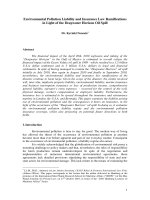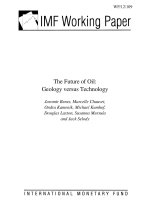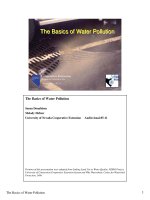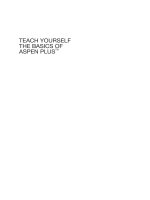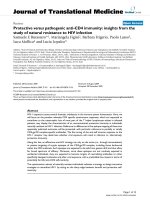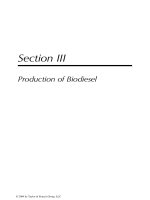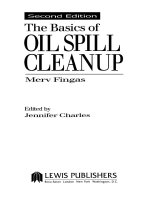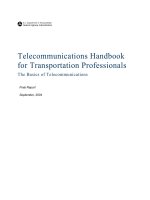The Basics of Oil Spill Cleanup - Chapter 12 potx
Bạn đang xem bản rút gọn của tài liệu. Xem và tải ngay bản đầy đủ của tài liệu tại đây (1.04 MB, 16 trang )
©2000 by CRC Press LLC
CHAPTER
12
Oil Spills on Land
While the vast majority of oil spills in Canada occur on land (see statistics in
Chapter 1), land spills are less dramatic than spills on water and receive less attention
from the media and the public. This chapter deals with the behaviour of oil spilled
on land and describes common methods of containment and cleanup for such spills.
Two types of land spills are discussed — those that occur primarily on the surface
of the land and those that occur partially or totally in the subsurface. The sources
and the cleanup methods differ for these types of spills. Most surface spills in Canada
are the result of oil production, such as spills from pipelines and battery sites,
whereas most subsurface spills are from leaking underground fuel storage tanks or
pipelines. Whether on the surface or subsurface, however, each spill is unique in
terms of the type of material spilled, the habitat in which the oil is spilled, its location,
and the weather conditions during and after the spill.
Protecting human health and safety is still the top priority when cleaning up oil
spills on land and in the subsurface, although this is only an issue with some spills,
such as gasoline. Minimizing long-term damage to the environment and protecting
agricultural land are more often the main concerns with spills on land. This is
followed by protecting nonessential uses, such as recreation.
BEHAVIOUR OF OIL ON LAND
The spreading of oil across the surface and its movement downwards through
soil and rock are far more complicated and unpredictable on land than the spreading
of oil on water. The movement of the oil varies for different types of oil and in
different habitats and is influenced by conditions at the spill site, including the
specific soil types and their arrangement, moisture conditions in the soil, the slope
of the land, and the level and flow rate of the groundwater. Other factors, which
vary in different habitats, are the presence of vegetation and its type and growth
phase, the temperature, the presence of snow and ice, and the presence of micro-
features, such as rock outcrops. Some properties of different oils and their effects
on the environment are shown in Table 15.
©2000 by CRC Press LLC
The basic types of soil to consider in relation to oil spills are sand/gravel, loam,
clay, and silt. “Soil” is defined as the loose unconsolidated material located near the
surface, while “rock” is the hard consolidated material, i.e., bedrock, usually found
beneath the soil. Most soils consist of small fragments or grains that form openings
or pores when compacted together. If these pores are sufficiently large and inter-
connected, the soil is said to be “permeable” and oil or water can pass through it.
Sand is the most permeable type of soil. Materials such as clay, silt, or shale are
termed “impervious” as they have extremely small, poorly interconnected pores and
allow only limited passage of fluids. Soils also vary in terms of long-term retentivity.
Loam tends to retain the most water or oil due to its high organic content.
As most soils are an inhomogeneous mixture of these different types of soil, the
degree of spreading and penetration of oil can vary considerably in a given location.
The types of soil are often arranged in layers, with loam on top and less permeable
materials such as clay or even bedrock underneath. If rock is fractured and contains
fissures, oil can readily pass through it.
Table 15 Properties of Different Oils and their Effect on the Environment
Petroleum
Plant
Toxicity
Water
Threat Viscosity Adhesion Penetration Degradation
Gasoline 5 5 1 1 5 4
Diesel fuel 2 3 2 2 4 1
Light crude 4 4 3 3 3 2
Heavy crude 3 2 4 4 2 3
Bunker fuel 1 1 5 5 1 5
Lower numbers indicate more favourable conditions to the environment and faster
recovery after a spill.
Photo 131
This inland spill was so large that cleanup crews used an airboat to travel over
the oil. (Oil Spill Response Limited)
©2000 by CRC Press LLC
The oil’s ability to permeate soils and its adhesion properties also vary signifi-
cantly. Viscous oils, such as bunker fuel oil, often form a tarry mass when spilled
and move slowly, particularly when the ambient temperature is below their pour
point. Non-viscous products, such as gasoline, move in a manner similar to water
in both summer and winter. For such light products, most spreading occurs imme-
diately after a spill.
Crude oils have intermediate adhesion properties. In an area with typical agri-
cultural loam, spilled crude oil usually saturates the upper 10 to 20 cm of soil and
rarely penetrates more than 60 cm. Generally, the oil only penetrates to this depth
if it has formed pools in dry depressions. If the depressions contain water, the oil
may not penetrate at all.
Movement of Oil on Land Surface
Both the properties of the oil and the nature of the soil materials affect how
rapidly the oil penetrates the soil and how much the oil adheres to the soil. For
example, a low viscosity oil penetrates rapidly into a dry porous soil such as coarse
sand and therefore its rate of spreading over the surface is reduced.
When oil is spilled on land, it runs off the surface in the same direction and
manner as water. The oil continues to move horizontally down-gradient until either
blocked by an impermeable barrier or all the oil is absorbed by the soil. The oil will
also sink into any depressions and penetrate into permeable soils.
The process whereby oil penetrates through permeable soils is shown in Figure
30. The bulk of the oil moves downward through permeable material under the
influence of gravity until it is stopped by either the groundwater or an impermeable
layer. It then moves down-gradient along the top of the impermeable layer or
groundwater until it encounters another impermeable barrier or all the product is
absorbed in the soil. Once in contact with the water-soluble material, the oil dissolves
into and is transported away with the groundwater. Oils and fluids can flow along
the top of the groundwater and reappear much later in springs or rivers.
The descending oil is often referred to as a “slug” of oil. As the slug moves
through the soil, it leaves material behind that adheres to the soil. This depends on
the adhesion properties of the spilled product and the nature of the soil. More of
the adhered oil is moved downwards by rainfall percolating through the soil. The
rain water carries dissolved components with it to the water table. The movement
of the oil will be greatest where the water drainage is good.
Movement of Oil in the Subsurface
Regardless of its source, oil released into the subsurface soil moves along the
path of least resistance and downwards, under the influence of gravity, as shown in
Figure 31. Oil often migrates towards excavated areas such as pipeline trenches,
filled-in areas around building foundations, utility corridors, and roadbeds. Such
areas are often filled with material that is more permeable or less compacted than
the material removed during the excavation.
©2000 by CRC Press LLC
The oil may continue to move downwards until it reaches the groundwater or
another impermeable layer. If the soil is absorptive and capillary action occurs,
however, the oil can also move upwards and even reappear at the surface, sometimes
as far as a kilometre away from the spill. This is what happens when pipeline spills
appear at the surface of the trench in which the pipeline is laid.
Habitats/Ecosystems
As the effects of oil and its behaviour vary in different habitats, cleanup tech-
niques and priorities are tailored to the habitat in which the spill takes place.
Returning the habitat as much and as quickly as possible to its original condition is
always a high priority when cleaning up oil spills.
It is important to note that each site may be very inhomogeneous in terms of its
vegetation, soil types, and soil profile, and how the oil behaves in or affects each
component of the soil. Furthermore, the amount of time it takes for the vegetation
to grow back naturally differs widely from one habitat to another. The estimated
amount of time for surface vegetation to recover in various oiled habitats is shown
in Table 16. Residual amounts of oil remain in some habitats for many years or even
decades.
When spills occur in the
urban habitat
, protecting human health and safety and
quickly restoring the land use are top priorities. Environmental considerations are
generally not important as endangered species or ecosystems are not often found in
the urban habitat. The urban environment usually includes a range of ecosystems,
from natural forest to paved parking lots. Thus a spill in an urban area often affects
several ecosystems, each of which is treated individually.
Figure 30
Penetration of oil into soil.
Impermeable bedrock
Groundwater flow
Main mass (soil completely saturated)
Area of partial saturation with oil
Spread of oil on surface
of groundwater
Groundwater level
©2000 by CRC Press LLC
The
roadside habitat
is similar to the urban one in that restoring the use and
surficial appearance of the land is given top priority. Roadside habitats are varied
and include all the other ecosystems. The roadside habitat is different from the urban
one, however, in that it is exposed to many emissions and is not generally viewed
as a threatened or sensitive environment.
On
agricultural land
, the priority in cleaning up oil spills is to restore land use,
e.g., crop production. In this habitat, oil is more likely to penetrate deeply into the
subsurface as plowing the fields creates macropores that petroleum products and
crude oils can rapidly penetrate. As oil penetrates deeper into dry agricultural land,
the danger of groundwater contamination is greater than in other habitats.
Figure 31
Subsurface movement.
Table 16 Estimated Recovery Times in Various Habitats
Habitat
Recovery Time
without Cleanup
(years)
Recovery Time
with Minimal Cleanup
(years)
Recovery Time
with Optimal Cleanup
(years)
Urban 1 to 5 1 <1
Roadside 1 to 5 1 <1
Agricultural Land 2 to 10 1 to 3 1 to 2
Dry Grassland 1 to 5 1 to 2 1
Forest 2 to 20 2 to 5 1 to 3
Wetland 5 to 30 3 to 20 2 to 10
Taiga 3 to 20 2 to 10 2 to 8
Tundra 3 to 10 2 to 8 1 to 5
Water
table
Oil spill
Entry
of oil
into river
Movement of water table
Oil storage
in old landfill
Surface and near-surface
movement of oil
©2000 by CRC Press LLC
On mineral soils, however, oil can make the soil non-wettable, so that water runs
off rather than soaking into the soil. This causes a water shortage, which can result
in poor rehabilitation in the area. The opposite occurs in low-lying sites or poorly
drained soils where water fills the macropores of the soil, but is not absorbed into
the soil itself because of the presence of the oil. This excludes air from the soil and
the site becomes difficult to treat or cultivate and anaerobic conditions quickly
develop.
Anaerobic conditions and restricted plant growth can also develop when oil on
the surface weathers and forms an impermeable crust that again reduces the air
exchange. Recovery is affected by the amount of oil spilled on a given area. Lightly
oiled soil recovers much faster than a heavier oiled area as the soil is not completely
saturated and both air and water can still penetrate. Residual oil in the soil can also
slow recovery by inhibiting seed germination.
Dry grassland
is similar to agricultural land in that the priority for cleanup is
restoring the soil so that the crop, in this case grass, can continue to grow. The
surface of the grassland is often less permeable than agricultural land. Once the
surface is penetrated, however, the substrate may be permeable and groundwater
can be affected. Dry grassland recovers quickly from spills if the oil runs off or if
the excess oil is removed without too much surface damage. The presence of dead
vegetation is viewed as a symptom, not a problem. When excess oil is removed,
replanting and fertilization can speed recovery of an oiled grassland. As with agri-
Photo 132
The oiled banks of this stream show how high the oil spill once was. (Ed Owens)
©2000 by CRC Press LLC
cultural land, oil on the surface of grassland can sometimes weather and form an
impermeable crust that reduces air exchange and causes anaerobic conditions.
Unlike most habitats, the
forest
has two distinct levels of vegetation: low-lying
vegetation such as shrubs and grasses, and trees. The low-lying vegetation is much
more sensitive to oiling than trees, but is much easier to replant and recovers much
faster. Most species of trees are not seriously affected by light oil spills. If enough
oil is spilled to affect the tree’s roots, most trees will be killed and the forest will
not recover fully for decades. It is therefore very important to rapidly remove excess
oil that has not yet been absorbed by the soil.
If a forest has mineral soil, the oil can make it non-wettable so that water runs
off the soil rather than soaking in. In low-lying sites or forests with poorly drained
soil, the opposite occurs. Water fills the macropores of the soil, but not the soil itself
because of the presence of the oil. This excludes air from the soil and the site does
not revegetate quickly. Oil on the surface of forest soils can weather and form an
impermeable crust that also reduces air exchange or restricts the growth of plants.
Due to the presence of large trees, the forest is far more difficult to access and treat
than most other habitats.
Wetlands
are the habitat most affected by oil spills because they are at the
bottom of the gravity drainage scheme. Usually, oil cannot flow out of a wetland
system and oil from other areas flows into the system. Although there is a variety
of wetlands, oil tends to collect in all of them, creating anaerobic conditions that
slow oil degradation. Wetlands are also extremely sensitive to physical disturbance
as many plants in this habitat propagate through root systems. If these root systems
are damaged by the oil or the cleanup process, it takes years or even decades for
Photo 133
This oil in a low-lying grassland has been here for about 30 years. (Environment
Canada)
©2000 by CRC Press LLC
the plants to grow back. Wetlands are the habitat of many species of birds and fish,
as well as other aquatic resources. Wetlands are difficult to access and to clean up.
Taiga
, which is characterized by coniferous trees and swampy land, generally
forms the transition between northern forests and the tundra farther to the north. It
is either underlain by permafrost or has a high water table. Many of the plants
propagate through root systems and are highly sensitive to physical disturbance.
Over a period of time, heavy loadings of oil will kill the coniferous trees. Oil on
the surface of the taiga can weather and form an impermeable crust that reduces the
air exchange and restricts plant growth. Degradation of remaining oil is slow in this
habitat, which takes a long time to recover. The presence of trees and the high
moisture level make the taiga more difficult to access and clean up than most other
habitats.
Tundra
is the far northern habitat, characterized by low plant growth and no
trees. Tundra is underlain by permafrost that is generally impermeable to oil. Veg-
etation on the tundra grows in tufts that are generally grouped into polygons. Oil
spilled on the surface drains into the spaces between the tufts and polygons and
eventually kills the vegetation. Without the layer of vegetation, the permafrost melts
and serious land damage results. Degradation of remaining oil on the tundra is very
slow and could take hundreds of years.
Photo 134
This area was oiled about 25 years ago and vegetation has still not been re-
established. (Environment Canada)
©2000 by CRC Press LLC
In all the more sensitive habitats, which include the forest, the taiga, and the
tundra, the priority for cleanup operations is to remove the excess oil as rapidly as
possible and without causing physical damage.
Cleanup of Surface Spills
When dealing with oil spills on land, cleanup operations should begin as soon
as possible. It is important to prevent the oil from spreading by containing it and to
prevent further contamination by removing the source of the spill. It is also important
to prevent the oil from penetrating the surface and possibly contaminating the
groundwater.
Berms or dikes
can be built to contain oil spills and prevent oil from spreading
horizontally. It must be ensured, however, that the oil does not back up behind the
berm and permeate the soil. Berms can be built with soil from the area, sand bags,
or construction materials. Berms are removed after cleanup to restore the area’s
natural drainage patterns.
Sorbents
can also be used to recover some of the oil and
to prevent further spreading. The contaminated area can sometimes be
flooded
with
water to slow penetration and possibly float oil to the surface, although care must
be taken not to increase spreading and to ensure that water-soluble components of
the oil are not carried down into the soil with the water.
Shallow trenches
can be
dug as a method of containment, which is particularly effective if the water table is
high and oil will not permeate the soil. Oil can either be recovered directly from
the trenches or burned in the trenches. After the cleanup, trenches are filled in to
restore natural water levels and drainage patterns.
A variety of methods exist for cleaning up surface oil spills on land, with the
method used depending on the habitat in which the spill occurs. The various methods
and which should be used in the different habitats are shown in Table 17.
Natural Recovery
This is the process of leaving the spill site to recover on its own. This method
is sometimes chosen for extremely sensitive habitats such as wetlands, taiga, and
tundra and is always done
after
the excess oil has been removed from the site. In
these cases, the excess oil that can be recovered is removed using techniques that
do not disturb the surface or physically damage the environment. This is important
as it can take years for wetlands or tundra to recover from vehicular traffic. In habitats
such as wetlands and taiga where the vegetation propagates through root systems,
more damage can be done by the cleanup operation than by the oil.
Removal of Excess Oil
Any excess oil that can be recovered without causing physical damage to the
environment is always removed from a spill site, using techniques that do not disturb
the surface. If excess oil on the surface is not removed quickly, the oil can penetrate
into the soil, contaminating the groundwater and destroying vegetation.
©2000 by CRC Press LLC
Suction hoses, pumps, vacuum trucks
, and certain
skimmers and sorbents,
both natural and synthetic, are generally effective in removing excess oil from the
surface, especially from ditches or low areas. The use of sorbents can complicate
cleanup operations, however, as contaminated sorbents must be disposed of appro-
priately. Sorbents are best used to remove the final traces of oil from a water surface.
Any removal of surface or vegetation also entails replanting and fertilization.
Manual removal
of oil involves removing oil and often highly oiled soil and
vegetation with shovels and other agricultural tools. This is always followed by
fertilization, selective reseeding, or transplanting plugs of vegetation from nearby
Table 17 Cleanup Methods for Surface Land Spills
Habitat
Removal
of Excess
Oil
Natural
Recovery
Manual Oil
Removal
Mechanical
Oil/Surface
Removal
Enhanced
Bio-
degradation
In-Situ
Burning
Hydraulic
Measures
Urban
√
+
√
++
◊
√
Roadside
√
+
√
++++
Agricultural
land
√
+
√
+++
√
Grassland
√
+
√
++++
Forest
√√√
++
◊
√
Wetland
√√√ ×
+
√
+
Taiga
√√√ ×
+++
Tundra
√√√ ×
+++
√
—
acceptable or recommended
+
—
can be used under certain circumstances
×
—should not be used
◊
—only marginally acceptable
Photo 135
This spill is being recovered with pumps and a vacuum truck. (Environment
Canada)
©2000 by CRC Press LLC
unaffected areas. This form of removal is labour-intensive and can severely damage
the surface, especially in sensitive environments.
Mechanical recovery equipment
, such as bulldozers, scrapers, and front-end
loaders, can cause severe and long-lasting damage to sensitive environments. It can
be used in a limited capacity to clean oil from urban areas, roadsides, and possibly
on agricultural land. The unselective removal of a large amount of soil leads to the
problem of disposing of the contaminated material. Contaminated soil must be
treated, washed, or contained before it can safely be disposed of in a landfill site.
This can cost thousands of dollars per ton.
Other Cleanup Methods
Enhanced biodegradation
is another possible method for cleaning up spills on
land. Certain portions of oil are biodegradable and the rate of biodegradation can
sometimes be accelerated as much as tenfold by the proper application of fertilizers.
For example, in one study, an oil spill on tundra showed good degradation when a
phosphorus fertilizer was applied. The amount of nutrients added is often calculated
on the ratio of 100:10:1 C:N:P, where C is the carbon represented by the oil, N is
the nitrogen, and P is the phosphorus.
The amount of degradation varies with the type of oil. Diesel fuel will largely
degrade on the land surface, whereas Bunker C will only slightly degrade. Under
ideal conditions and using fertilizers to enhance degradation, however, it can still
take from 3 to 100 years for more than half of an oil to degrade, even if this oil is
biodegradable. During this time, some of the oil will be removed by other processes
such as evaporation or simply by movement.
Scientists are now exploring the use of plants and their associated microorgan-
isms for remediation, which is called
phytoremediation
. This is a low cost process
that is proving effective for a wide variety of contaminants, including petroleum
hydrocarbons. It can be used in combination with other remediation technologies
and may prove useful in the future for treating oiled soils or wetlands. It takes several
years to remediate a site and cleanup is limited to the depth of the soil within reach
of the plant’s roots.
In-situ
burning
has been used for several years to deal with oil spills on land.
This technique removes oil quickly and without disturbing the area extensively,
although it does damage or kill shrubs and trees. The heat from burning can also
destroy propagating root systems and change the soil’s properties. In addition, it can
leave a hard crust of residual material that inhibits plant growth and changes natural
water levels and drainage patterns.
These disadvantages can be overcome in some habitats. Some areas can be
flooded before burning to minimize the effect of the heat and to remove oil by
floating it out of the ground. Crust formation can be avoided by physically removing
residue after a burn. On wetlands and in areas with high water levels, sorbents can
be used to remove residues left after burning to ensure that they do not coat plants
or soil after water levels fall. In marshes, burning is best done in spring when the
water table is high.
©2000 by CRC Press LLC
Hydraulic measures
, such as flooding and cold or warm water sprays, can be
used to deal with land spills, although they are only effective in limited circum-
stances.
Flooding
an area where the oil is not strongly retained can cause the oil to
rise to the water’s surface where it can subsequently be removed using skimmers or
suction devices, or by burning. This is effective in areas where the water table is
high or the top layer of ground is underlain by impermeable material. Flooding may
not work on soils that are high in organic material, however, as they strongly retain
oil.
Cold or warm water sprays
can be used to clean oil from hard surfaces.
Catchment basins and interceptor trenches are built to capture the released oil, which
is then skimmed or pumped from the trenches.
A number of other techniques have been tried for cleaning up oil spills on land,
with varying degrees of success.
Tilling or aeration of soil
is done to break up the
crust surface and re-aerate the soil. In areas where vegetation propagates by root
systems, however, tilling kills all plants and destroys the potential for re-growth.
Tilling oil into the soil can actually slow natural degradation because the soil
becomes anaerobic when it re-compresses.
Vegetation cutting
is useful only if there
is a risk that oil on vegetation could re-contaminate other areas. Many plants cannot
survive cutting, however, and growth is not re-established in the area. To date, there
are no effective
chemical agents
for cleaning up oil spills. Surfactant agents can
actually increase oil penetration into the soil and could result in the more serious
problem of groundwater contamination.
All cleanup methods include
site restoration
, which involves returning the site
as closely as possible to the pre-spill conditions. The drainage pattern of the site is
restored by removing dykes, dams, and berms, and filling in ditches or drains. It
may be necessary to replace any soil that was removed and to re-vegetate the site
by fertilizing, re-seeding, or transplanting vegetation from nearby.
Cleanup of Subsurface Spills
Oil spills in the subsurface are much more complicated and expensive to clean
up than those on the surface and the risk of groundwater contamination is greater.
Spills in the subsurface can be difficult to locate and without a knowledge of the
geology of the area, it can be difficult to predict the horizontal and downward
movement of the oil.
Initially, the oil must be contained and its horizontal and downward movement
stopped or slowed. Containment methods are difficult to implement and may cause
physical damage to the site. Digging an
interceptor trench
can be effective in
reducing horizontal spread. Such trenches are filled in after the cleanup operation
to restore the natural drainage patterns of the land. Another method is to place
“walls” around the spill source to stop its spreading. These can be “slurry walls”
consisting of clay or cement mixtures that solidify and retain the oil, or solid sheets
of steel or concrete can be positioned to retain the oil.
Once the subsurface spill is contained, there are a number of cleanup methods
that can be used. The most appropriate method for a particular spill depends on the
type of oil spilled and the type of soil at the site, as shown in Table 18.
©2000 by CRC Press LLC
Hydraulic measures
for cleaning up subsurface spills include flooding, flushing,
sumps, and French drains. These methods are most effective in permeable soil and
with nonadhesive oils. They all leave residual material in the soil, which may be
acceptable, depending on the land use.
Flooding
is the application of water either
directly to the surface or to an interceptor trench in order to float out the oil. Flooding
is effective only if the spilled oil has not already been absorbed into the soil, if
sufficient water can be applied to perform the function, and if the oil is not acci-
dentally moved into another area.
Flushing
involves the use of water to flush oil
into a sump, recovery well, or interceptor trench. Placement of
a sump
or a deep
hole is only effective for a light fuel in permeable soil above an impermeable layer
of soil. A
French drain
is a horizontal drain placed under the contamination, from
which the fuel and often water are pumped out. Although effective in permeable
soils, they are expensive and difficult to install.
Interceptor trenches
are ditches or trenches dug down-gradient from the spill,
or in the direction in which the spill is flowing, to catch the flow of oil. They are
placed just below the depth of the groundwater so that oil flowing on top of the
groundwater will flow into the trench. Both water and oil are removed from the
trench to ensure that flow will continue. Interceptor trenches are effective if the
groundwater is very close to the surface and the soil above the groundwater is
permeable.
Table 18 Cleanup Methods for Subsurface Spills
Product Type in
Soil Type
Hydraulic
Measures
Interceptor
Trench
Soil
Venting
Soil
Excavation
Recovery
Wells
Gasoline in sand or
mixed till
√
+
√
++
Gasoline in loam or
clay + +
◊
+
√
Diesel fuel in sand
or mixed till
√
+
◊
+
+
Diesel fuel in loam
or clay
√
+
◊
+
√
Light crude in sand
or mixed till
√
+++ +
Light crude in loam
or clay
+
+
◊
++
Heavier oils in sand
or mixed till + +
◊
+
◊
Heavier oils in loam
or clay + +
◊
+
◊
√
—
acceptable or recommended
+
—
can be used under certain circumstances
◊
—only marginally acceptable
©2000 by CRC Press LLC
Soil venting
is done to remove vapours from permeable soil above a subsurface
spill. This is effective for gasoline in warm climates and for portions of very light
crude oils. Other oils do not have a high enough rate of evaporation to achieve a
high recovery rate. Venting can be passive, in which vapours are released as a result
of their own natural vapour pressure, or active, in which air is blown through the
soil and/or drawn out with a vacuum pump. The fuel vapours are subsequently
removed from the air to prevent air pollution. Soil venting is also done to enhance
biodegradation.
Excavation
is a commonly used technique for cleaning up subsurface spills,
especially in urban areas where human safety is an issue. Vapours from gasoline
can travel through the soil and explode if ignited. These vapours can also penetrate
houses and buildings, forcing evacuation of the area. To prevent these situations,
contaminated soils are often quickly excavated and treated or packaged for disposal
in a landfill. Excavation may not always be possible, however, depending on the
size of the spill and prevailing conditions at the site.
Recovery wells
are frequently used in cleaning up subsurface spills. The well
is drilled or dug to the depth of the water table so that oil flowing along the top of
the water table will also enter the well. The water table is sometimes lowered, by
pumping, to speed the recovery of the oil and to increase the area of the collection
Photo 136
An interceptor trench is used to catch the oil flowing over the groundwater. (Environment
Canada)
©2000 by CRC Press LLC
zone. The oil is recovered from the surface of the water by a pump or a specially
designed skimmer.
Other methods are constantly being proposed or tried for cleaning up subsurface
spills. One such method is
biodegradation in-situ
, although its effectiveness is very
much restricted by the availability of oxygen in the soil and the degradability of the
oil itself. An adaptation of the venting method has been used to try to solve the
oxygen problem. So far, however, biodegradation methods have not been rapid
enough to be an acceptable solution.
Chemical agents
have also been proposed for
cleaning up subsurface spills, although most of them actually make the problem
worse. For example, surfactants can release the oil from soil, but then render it
dispersible in the groundwater. Government approval must be obtained before using
chemical agents.
If the groundwater does become contaminated, it is pumped to the surface and
treated to remove the dissolved components. Common treatment methods include
reverse osmosis and carbon filtration. Groundwater treatment is expensive and gen-
erally involves a lengthy process before contamination levels are below acceptable
standards.
